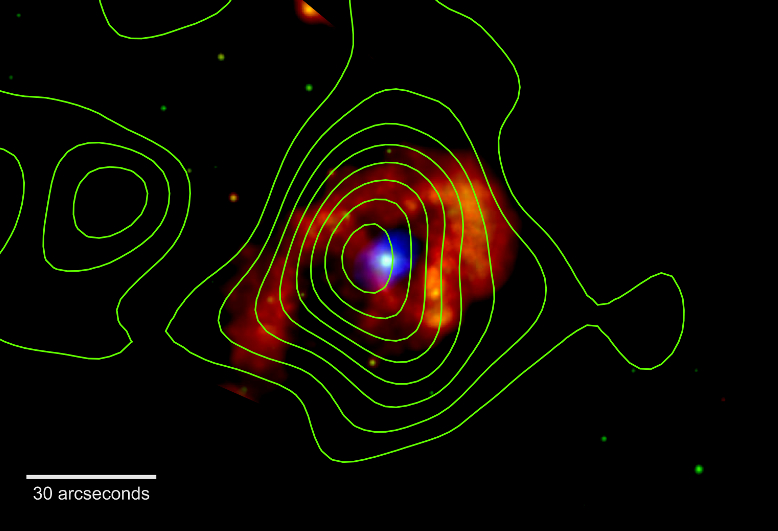
 Credit: NASA/CXC and NASA/JPL-Caltech
Credit: NASA/CXC and NASA/JPL-Caltech
Shocking Processes from Eta Carinae
The superluminous, doomed star known as Eta Carinae is one of the most intriguing stars within 10,000 light-years from earth. It's best know for its extreme brightening and subsequent dramatic fading in the middle of the 19th century, an event as energetic as a small supernova, which, somehow, the star survived. We know from X-ray and other observations that Eta Carinae is actually a binary system, in which the brighter, more massive star is orbited by a mysterious, unseen companion star in an unusally elliptical orbit. X-ray emission is produced by the collision of the wind from the brighter star with the companion's wind. The collision of the winds creates a "bow-shock" around the companion star as it plows through the thick slow wind of the brighter star. The energy of the collision is converted to heat, raising temperatures in the bow shock to tens of millions of degrees, producing X-rays. This bow shock moves around the orbit with the motion of the companion star, and periodically lights up different regions of the ejected gas and dust which surround the binary. There's also a mysterious source of very high gamma ray emission, detected by both NASA's Fermi Gamma-ray Space Telescope and by ESA's INTEGRAL space observatory. Now observations with the NuSTAR observatory have conclusively identified Eta Carinae as the source of this unusual high energy X-ray emission. The image above shows a NuSTAR high energy X-ray image of Eta Carinae as green contours superimposed on a Chandra X-ray Observatory X-ray image of Eta Carinae. The NuSTAR contours pinpoint the high energy X-ray source as originating from very near the binary system (which is shown as the blue-white X-ray source near the center of the Chandra image). Variations in the hard source seen by NuSTAR show that the source varies with the binary orbit, and confirm that the emission originates from Eta Carinae. In addition, the high energy emission seen by NuSTAR smoothly connects with the gamma-ray emission seen by Fermi. These observations indicate that the high energy X-ray and gamma-ray emission is produced by electrons which are accelerated to near the speed of light by the tremendous power of the colliding wind bow shock. These electrons in turn bounce off optical light, increasing the energy of the optical light up to the gamma-ray region, producing the gamma rays seen by Fermi.
Published: July 9, 2018
<
HEA Dictionary ● Archive
● Search HEAPOW
● Other Languages
● HEAPOW on Facebook
● Download all Images
● Education ● HEAD
>

Each week the HEASARC
brings you new, exciting and beautiful images from X-ray and Gamma ray
astronomy. Check back each week and be sure to check out the HEAPOW archive!
Last modified Tuesday, 27-Feb-2024 10:10:05 EST


